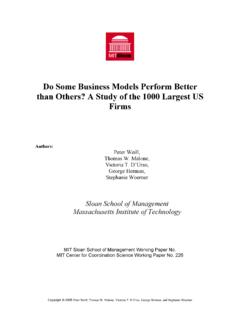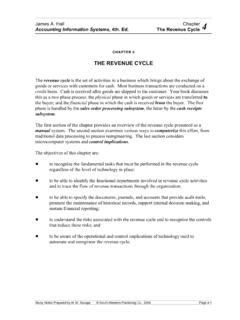Transcription of How to Perform a Market Study: A Step-by-Step Guide
1 How to Perform a Market study : A Step-by-Step GuidePayScale, Inc with Sharon Koss, CCP, SPHRA 10-page, Step-by-Step Guide for performing a salary Market study for HR Executives and Compensation Professionals. Appropriate for non-profit, for-profit and government organizations of all sizes and industries. Includes a detailed planning 1: Create your Market study PlanStep 2: Research your survey options and select your sourcesStep 3: Collect your dataStep 4: Working with the numbersStep 5: Make sure it makes senseStep 6: Finalizing your recommendations and completing your Market studyIntroductionThis whitepaper will walk you through the six steps of performing an external Market study also referred to as benchmarking regardless of your organization s size or industry.
2 (We ll address how to assess Internal Equity in a separate whitepaper.)Determining the appropriate pay levels for individuals in your company is essential to your business for a number of reasons: attracting and retaining talent, creating (and keeping) a competitive edge, managing the bottom line, and maintaining your organizations reputation. Without a thoughtful understanding of both external compensation factors (local job markets, your competitions pay levels, demand within your industry) and internal factors (size and makeup of your organization, detailed job descriptions, value of positions to the company), it s near impossible to accurately assign compensation to employees.
3 Step 1: Create your Market study Plan It s tempting to skip planning and just jump right in, but performing a Market study and doing it well can be a bit of a daunting, time-consuming task. And remember, you ll need some budget for this, and whenever you re spending your company s money, you want to make sure you re spending it wisely. A plan will help. Don t worry depending on the scope of your study , your Market study Plan can range from a single page to a five-page overview of what you hope to achieve. First, make sure you have job descriptions for everyone in your organization. It s okay if they re not 100% complete, but it will be critical for matching skills, responsibilities and experience tied to each position, since you can t count on surveys to use the same titles that you do.
4 (If you re crafting descriptions from scratch, make sure employees or managers have agreed on the duties, experience and education required for each position).Next, start building your plan. The plan can be flexible, but it should give you a decent guidepost to where you re heading and let others know why, how, and when you re tackling this study . Open up a new document and get started! Let s start with the WHY. You re reading this whitepaper for a reason .. what is it? Do you promote an annual effort to review salaries? Is there a team that the organization feels is over- or under- paid? Are you losing key employees? Having a hard time recruiting fresh talent into a particular business need?
5 Whatever your reason, your stated objective should tie back to your business reason for performing the Market study . For example: We are conducting a Market study because sourcing a strong leader in Quality Assurance has proven challenging since we re not making competitive enough compensation offers. The Engineering Team needs QA talent to keep our business on track for Holiday 2008. If we don t ship on time, we risk 30% of our projected profits. This study will ensure that we are offering competitive pay for our positions. Now, it s time to establish your goals. These might be set by you, or they may be dictated from another leader in your organization.
6 For example, you could be tasked with reducing management pay by 10% in the next 18 months. Or Your Market study PlanA solid plan will include the following: Objective: Why are you conducting this study ? Goals: What are your top 3-5 goals? Success Metrics: How will you (and others) know if the study was successful? Budget: What will the outside research cost? Do you need to include internal time, or consulting fees? Timeline: How long will it take, and what are the major milestones along the way?you might be trying to establish that a 5% pay increase for key players can stave off a retention issue you re facing. The more specific your goals, the better.
7 And keep it down to 2-5 primary objectives; any more and you ll lose focus during the goals will also help you prioritize which employees, teams or talent you should first focus on, especially if your company has more than 100 employees. (After all, you can always Perform additional Market studies to manage less-critical groups later in the year.) Next, outline your approximate budget and resources needs. Typically there are two major costs to conducting a Market study data and consultant time. If you plan to do the study in house, you ll only need to budget for survey data. If you are relying on outside help, don t forget to add consulting fees into your budget, and understand what s included upfront.
8 Remember, Market studies are a time-intensive project, be sure to set aside plenty of time for matching, analyzing and setting your pay rates. Once you have chosen your research tools you ll have tighter , craft a timeline for your benchmarking. The checklist included in this whitepaper is for 6 months, for a study of approximately 100 employees. Feel free to adjust accordingly, based on your priorities and the scope of your study . (And be sure to pad your schedule by a couple of weeks, to account for those unexpected surprises that always come up in your daily job.) Specific tips about timing are included throughout this whitepaper, but you can always work back from your desired effective date to plan accordingly.
9 Step 2: Research your survey options and select your sources Once your plan has been written (and signed off on, if need be), you re ready to dig in to the more interesting parts of the process: figuring out which resources you ll use for your study . This is one of the biggest decisions an organization will make regarding its compensation system. It s an important (and can be an expensive) decision. The survey(s) you choose set the parameters for one of your company s biggest expense its out of the gate, you have lots of sources you can choose from. The three major categories are: Published, Traditional Surveys: From the government, associations or consulting firms, these offer a broad perspective, although may not be entirely up to date or matched to your Surveys: Very timely, inexpensive options for comparison, with easy-to-use online Surveys: Several firms are available who custom-design a survey just for your business that are often very accurate and very , you ll want to use at least 2 sources to work from, to guarantee the accuracy of your results.
10 Good salary survey information revolves around how timely the data is. The more organizations that participated the better and you ll want to use data with at least 10 organizations reporting in and 15 incumbents if available. How do you select the right surveys? Keep the following three things in mind when you re reviewing your options: 1. Use at least 2-3 salary surveys. It s startling how many organizations make million-dollar decisions with only one salary survey source. Using multiple surveys for each job match will help you determine what data is the best fit for your if the data is accurate for your needs. 2. Decide what your labor Market is for your positions.

![[Company X]’s Compensation Philosophy](/cache/preview/d/4/f/f/0/3/2/1/thumb-d4ff032107016b4c34cf9cce40e96033.jpg)









